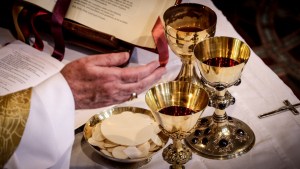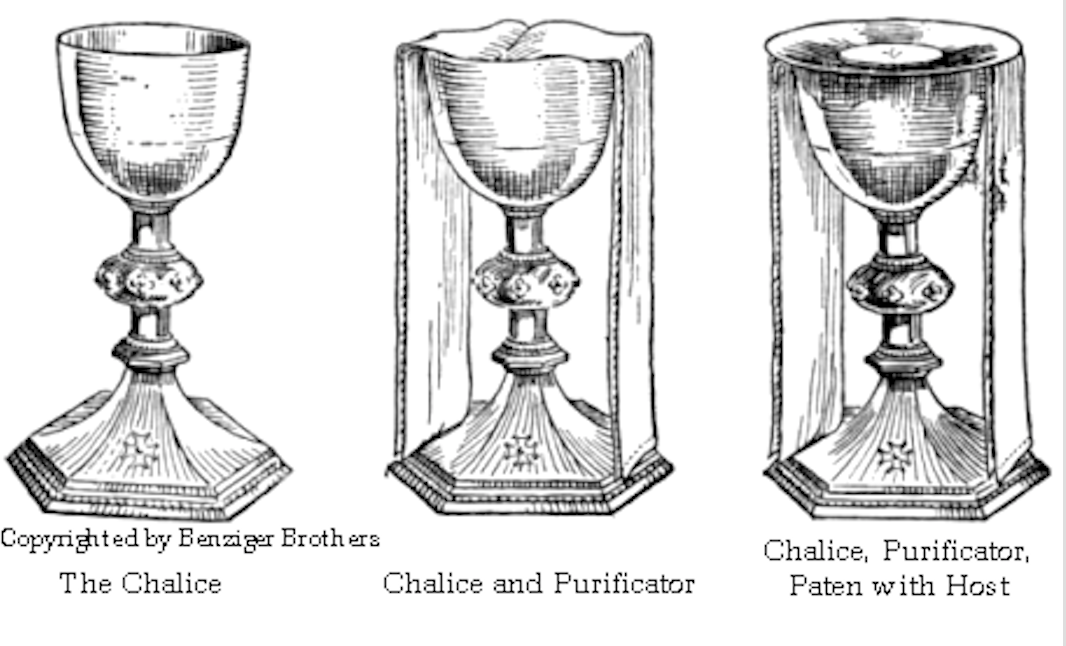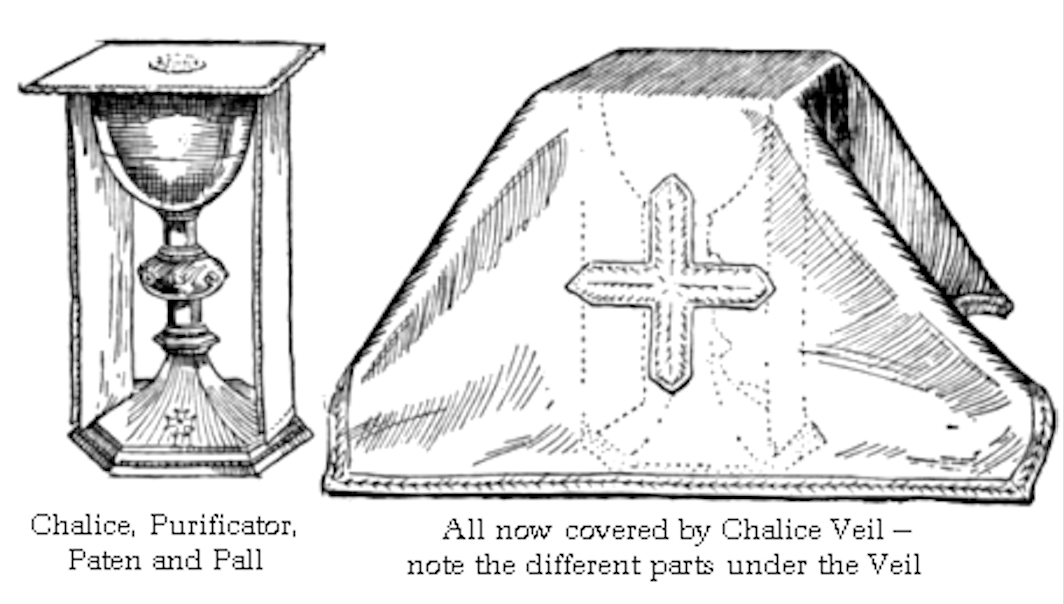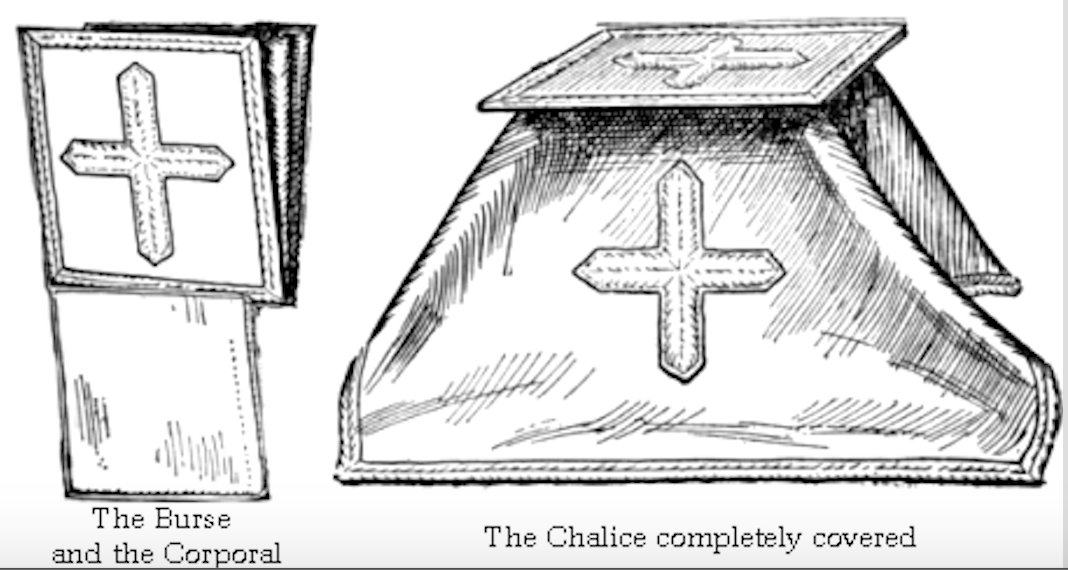And Jesus Cried Again With Loud Voice Catholic
The names and functions of the objects the priest uses in celebrating the Eucharist
Centuries ago, the congregation did not see much of what was going on at Mass. Today, still, in the Western Church, the priest'south actions at the altar are in full view.
Most of us, if we weren't altar servers or sacristans, got our one and only introduction to the sacred vessels and linens used at Mass when nosotros were being prepared for our Get-go Communion. In example that lesson has receded into the dimness of memory, hither's a refresher course on the objects used in front of your eyes at Mass.
At that place is a special order in the manner these vessels and linens are assembled before Mass. The analogy below helps identify the diverse objects.
The chalice (from the Latin discussion calyx, or cup) is the cup into which vino and a little h2o are mixed. At the consecration of the Mass, the wine (that in the beaker also as wine in a flagon to exist poured into smaller chalices if the congregation will receive nether both Species) becomes the Precious Blood of Jesus, in which Christ is truly present — Trunk and Blood, Soul and Divinity. The chalice is usually beautifully designed, and must be at to the lowest degree lined with precious metal as a sign of respect. In religious art, the chalice is sometimes shown at the foot of the cantankerous, capturing the blood and h2o that flowed from the wound in Jesus' side.

Read more:
The spiritual reason chalices are made from precious metal
Over the chalice is laid the purificator, a fine white linen cloth that is used to wipe the lips and fingers of the priest and to cleanse the chalice afterwards Communion. The sacristan — the person who cares for the sacred vessels and linens — cleans the purificator separately from other linens after Mass, because it holds traces of the Precious Claret.

The paten (from the Latin word for pan or plate) is a saucer-like circular dish of or lined with precious metal. At Mass, the priest places the large main host on the paten, where at the consecration it (and other smaller hosts to be received by the congregation, held in a container called the ciborium) becomes the Body and Blood, Soul and Divinity of Jesus Christ. Where congregants receive Communion on the tongue, a server may hold a plate (also called a paten) under the communicant's mentum, so that no consecrated host or particle falls to the basis. In preparing the vessels for Mass, the paten with the large unconsecrated host is set atop the chalice, with the purificator underneath information technology.
Earlier the offertory of the Mass, the chalice is covered with a square of linen stiffened with paper-thin. This covering, called the pall (from the Latin word for "encompass") keeps foreign objects — like dust or insects — from falling into the chalice or onto the paten and contaminating them.

The prepared chalice, purificator, paten, and drape are then covered completely by a veil — a piece of fabric that reflects the liturgical color of the priest'due south vestments and is sometimes embellished with an appliqued or embroidered cross. The veil hides the sacred vessels from view. Fr. Jerry Pokorsky explains how the veil "reminds us of the curtain setting apart the Holy of Holies, and prompts united states of america to approach the chantry aware of our unworthiness to enter into union with God." Additionally, "The removal of the chalice veil is 1 of the offset liturgical actions at the Offertory in preparation for the reception of the gifts of breadstuff and wine from the congregation. The removal of the veil following the Liturgy of the Word signifies that the sacred mysteries are most to be revealed. Over again, this activity is a symbolic echo of the Scripture: 'And Jesus cried again with a loud voice and yielded up his spirit. And behold, the curtain of the temple was torn in two.'"
On top of the veiled vessels is placed the burse (from the Latin for bag or container), a square sack also made in the liturgical colour of the flavor, and may too be embellished with a cross.
The burse is a container for the corporal, a square slice of fine white linen that volition exist placed on the chantry underneath the chalice and paten. The corporal takes its proper noun from the Latin word for body, because the Torso of Christ will rest upon information technology.

The adjacent fourth dimension you are at Mass, watch during the Training of the Gifts every bit these sacred vessels and linens are unveiled and readied for the Eucharistic Prayer.
Enjoying your time on Aleteia?
Manufactures like these are sponsored free for every Catholic through the support of generous readers merely like you.
Cheers to their partnership in our mission, we achieve more than than 20 million unique users per month!
Aid united states of america continue to bring the Gospel to people everywhere through uplifting and transformative Catholic news, stories, spirituality, and more.
Support Aleteia with a gift today!

Source: https://aleteia.org/2017/09/14/heres-different-parts-of-a-chalice-and-their-functions-explained/
0 Response to "And Jesus Cried Again With Loud Voice Catholic"
Post a Comment